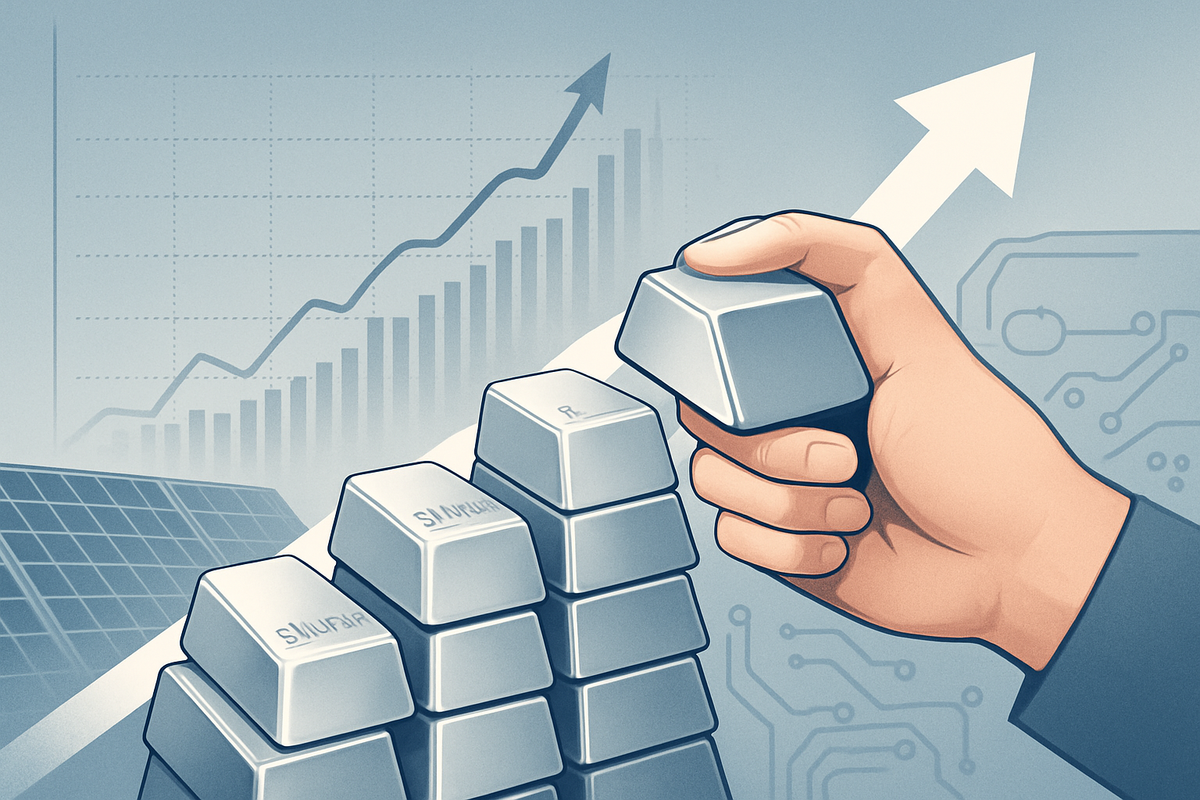
Silver, often overshadowed by its glittering counterpart gold, is currently stealing the spotlight in financial markets, experiencing an electrifying squeeze that has propelled its prices to multi-year highs. As of October 6, 2025, the white metal is not just flirting with, but actively pursuing new nominal records, igniting fervent discussions among investors and analysts alike. This dramatic surge, fueled by a potent cocktail of dwindling supply, ravenous industrial demand, and heightened investor interest, signals a potential revaluation of silver's intrinsic worth and could have profound implications for the broader precious metals market.
The immediate implications are clear: silver is undergoing a significant price discovery phase. Its robust performance, which has seen year-to-date gains exceeding 55%, is handily outperforming gold and drawing a fresh wave of capital into the sector. This squeeze is not merely speculative; it is underpinned by tangible market dynamics, suggesting that silver's ascent might be more than a fleeting rally, potentially reshaping investment strategies and commodity market outlooks for the foreseeable future.
The Unfolding Silver Saga: A Deep Dive into the Squeeze
Silver prices are currently trading robustly between $47 and $48.74 per ounce in spot markets, a level not seen in over a decade. This represents a staggering 52-53% increase year-over-year and an impressive 55% to 63.8% surge since the start of 2025. In India, a key market, one kilogram of silver touched ₹156,000 on October 6, 2025, reflecting the global upward trend. The metal is now within striking distance of its all-time nominal highs of $49.51 in 2011 and $49.45 in 1980, with the psychologically significant $50 per ounce threshold looming large.
The timeline leading to this moment has been building for years. The global silver market has faced persistent supply deficits for five to seven consecutive years, with demand consistently outstripping new mine production. This structural imbalance has been exacerbated by a recent acceleration in demand, particularly over the past year. September 2025 alone saw an impressive 16.1% growth in silver's value. Market experts, including TD Securities commodity strategist Daniel Ghali, have explicitly labeled the current environment as a "#silversqueeze you can buy into," pointing to critically low inventories in London Bullion Market Association (LBMA) vaults, soaring lease rates for physical silver, and an alarmingly high paper-to-physical ratio. These factors collectively indicate a severe scarcity of readily available physical metal.
The squeeze is primarily driven by a confluence of powerful forces. Firstly, persistent supply deficits continue to plague the market, as mine production struggles to keep pace with escalating demand. Silver is often a byproduct of mining other metals, making it difficult to ramp up production quickly. Secondly, surging industrial demand is a monumental driver. Silver's unparalleled electrical conductivity makes it indispensable in the rapidly expanding green energy sector, notably in solar panel manufacturing, electric vehicles (EVs), and 5G infrastructure. Solar panels alone consume approximately 140 million ounces of silver annually. Thirdly, heightened investment and safe-haven demand are propelling prices, as global economic uncertainties, geopolitical tensions, and inflationary pressures push investors towards precious metals. Silver, often dubbed "the commoner's gold," offers a more accessible entry point than its yellow counterpart. Finally, monetary policy expectations, particularly anticipated Federal Reserve interest rate cuts in late 2025, are reducing the opportunity cost of holding non-yielding assets like silver, while a weakening US dollar makes dollar-denominated commodities more attractive.
Initial market reactions are characterized by strong investor interest and a "buy-the-dip" mentality. Silver's outperformance against gold has drawn considerable attention, and bullion dealers are reporting increased physical premiums, signaling tightness in the physical market. While the outlook remains bullish, analysts caution that a decisive break above $50 could usher in a period of increased volatility, with potential for 3-5% daily swings and periodic corrections of 15-25%. The return of Chinese market participants after their Golden Week holidays is also a key point of discussion, with expectations ranging from easing the squeeze through increased liquidity to further driving prices higher as Chinese buyers potentially scramble for limited resources.
Corporate Fortunes: Winners and Losers in the Silver Rush
The dramatic surge in silver prices is creating clear winners and losers across various industries, particularly impacting public companies involved in the precious metals supply chain and those reliant on silver as a key input.
Silver mining companies stand to be the most significant beneficiaries. Miners like Fresnillo PLC (LSE: FRES), Pan American Silver Corp. (NASDAQ: PAAS), and Wheaton Precious Metals Corp. (NYSE: WPM), which specialize in silver extraction or hold substantial silver reserves, will see their revenues and profit margins swell with each upward tick in price. Higher realized prices for their output directly translate to improved financial performance, potentially leading to increased dividends, share buybacks, and expanded exploration budgets. Companies with lower production costs will see an even greater leverage to the rising price environment. Similarly, silver-backed exchange-traded funds (ETFs), such as the iShares Silver Trust (NYSEARCA: SLV), will directly benefit from the rising asset value of their underlying physical holdings, attracting more investor capital.
Conversely, companies heavily reliant on silver as an industrial input may face significant headwinds. Manufacturers of solar panels, electric vehicles, consumer electronics, and medical devices, where silver's unique properties are indispensable, could see their production costs escalate. Unless these companies have robust hedging strategies in place or can effectively pass on increased costs to consumers, their profit margins could be squeezed. For instance, a solar panel manufacturer that did not secure long-term silver contracts might find itself at a competitive disadvantage against rivals who did. While the underlying demand for their green energy products remains strong, the cost pressure from silver could force a re-evaluation of supply chains and product pricing strategies. This dynamic highlights the dual nature of silver as both a precious metal and a critical industrial commodity.
Broader Implications: A Shifting Landscape
Silver's current squeeze and its ascent to multi-year highs carry wider significance, reflecting and influencing broader industry trends, regulatory considerations, and historical market dynamics. This event underscores the increasing importance of commodities in a world grappling with supply chain vulnerabilities, geopolitical shifts, and an accelerating transition to green energy.
Firstly, this surge reinforces the strength of the broader precious metals market, even though silver's industrial demand component distinguishes it from gold. Gold's own impressive rally has set a bullish tone, but silver's even more dramatic outperformance suggests a deeper fundamental shift. It signals a robust appetite for tangible assets as a hedge against inflation and economic uncertainty, potentially pulling up other precious metals like platinum and palladium, which also have significant industrial applications. Secondly, the insatiable demand from the green energy transition is a monumental trend. Silver's critical role in solar panels and EVs is not just a temporary boost; it's a structural driver that will likely sustain high demand for decades. This event highlights how decarbonization efforts are directly impacting commodity markets, creating new demand centers and supply challenges.
From a regulatory and policy perspective, governments worldwide are pushing ambitious green energy targets, inadvertently bolstering demand for key materials like silver. While there are no direct "silver policies," the broader policy landscape favoring renewables and electric vehicles creates a powerful tailwind for silver prices. Monetary policy, particularly the anticipated easing by central banks like the Federal Reserve, is also a significant factor. Lower interest rates reduce the opportunity cost of holding non-yielding assets, making precious metals more attractive. Historically, periods of loose monetary policy and high inflation have often coincided with strong performance in precious metals.
Comparing the current rally to historical precedents like the 1980 Hunt Brothers squeeze and the 2011 surge reveals interesting insights. While current nominal prices are nearing those peaks, adjusted for inflation, the 1980 high would be approximately $192 per ounce today, and the 2011 peak around $69 per ounce. This suggests that despite the impressive gains, silver still has considerable room to grow to reach its historical inflation-adjusted values, indicating that the current rally, while significant, may not yet be in truly unprecedented territory when viewed through a long-term lens. This historical context suggests that the current revaluation could be a sustained trend rather than a short-lived bubble.
What Comes Next: Navigating the Volatile Path Ahead
The path forward for silver is poised to be dynamic and potentially volatile, presenting both substantial opportunities and significant challenges for market participants. The immediate focus will be on whether silver can decisively break and sustain above the psychological $50 per ounce threshold, a level that has historically proven to be a formidable resistance point.
In the short term, market watchers will be closely monitoring inventory levels in key vaults like the LBMA, any shifts in industrial demand reports, and the impact of the return of Chinese traders post-Golden Week. A sustained breach of $50 could trigger further speculative buying, but also potentially lead to increased volatility, with analysts warning of possible 15-25% corrections even within a bullish trend. This necessitates a cautious approach for short-term traders.
For the long term, the outlook for silver remains robust, underpinned by several fundamental drivers. The relentless growth in demand from the green energy sector, particularly solar and EVs, is expected to continue outstripping constrained mine supply, perpetuating the structural deficit. Furthermore, ongoing global economic uncertainties, geopolitical tensions, and the potential for sustained inflation will likely maintain strong investor interest in silver as a safe-haven asset and inflation hedge. The anticipated easing of monetary policy by central banks globally is also a significant tailwind, making non-yielding assets more appealing. Silver's dual role as both an industrial metal and a monetary asset positions it uniquely to benefit from these converging trends.
Market opportunities will likely emerge for investors in physical silver, silver mining stocks, and silver-focused ETFs, provided they conduct thorough due diligence and manage risk appropriately. Mining companies with strong balance sheets and proven reserves are particularly well-positioned. However, challenges will persist for industrial users of silver, who will need to adapt to higher input costs through strategic sourcing, hedging, and potentially exploring alternative materials where feasible. Potential scenarios range from a sustained upward trajectory, with silver establishing new nominal all-time highs and consolidating above $50, to periods of significant pullbacks as the market digests rapid gains before resuming its climb. The key will be the persistence of the demand-supply imbalance and the broader macroeconomic environment.
Comprehensive Wrap-up: Silver's Enduring Significance
The current silver squeeze, pushing prices to multi-year highs and challenging nominal records, is a pivotal event in the financial markets, highlighting the metal's enduring significance and its critical role in the global economy. The key takeaway is that silver's ascent is not merely speculative; it is fundamentally driven by a severe imbalance between dwindling supply and surging demand, particularly from the rapidly expanding green energy sector. This underscores silver's unique position as both a precious metal and an indispensable industrial commodity.
Moving forward, the market appears poised for continued bullish sentiment, albeit with an expectation of increased volatility as silver approaches and potentially breaches the $50 per ounce mark. This revaluation of silver's worth is likely to have a lasting impact, reinforcing its importance in investment portfolios as a hedge against inflation and economic instability, and cementing its status as a critical component of the future's sustainable technologies. The event also serves as a powerful reminder of how macro-economic trends, such as the green energy transition and monetary policy shifts, can dramatically influence commodity markets.
Investors should closely watch several key indicators in the coming months: the sustained demand from solar and EV manufacturing, the status of global silver inventories, further developments in central bank monetary policies, and any significant shifts in geopolitical stability. The ability of silver to maintain its momentum above $50 per ounce will be a crucial psychological and technical test. This period of heightened activity around silver is not just a story about a single commodity; it's a narrative about the evolving interplay of industrial progress, economic uncertainty, and investor sentiment in the 21st century.
This content is intended for informational purposes only and is not financial advice





